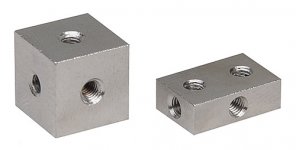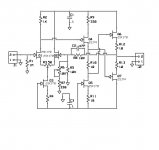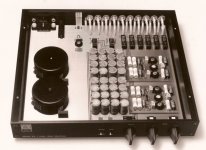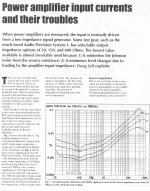What are the heatsinks for? Fashion statement or do the potentiometers and switches get hot?
Of course, you could build the volume and selector into the power amp, saving cabling, plugs, and jacks, but then you'd have an "integrated amp" which every right-thinking audiophile knows is mid-fi.
Of course, you could build the volume and selector into the power amp, saving cabling, plugs, and jacks, but then you'd have an "integrated amp" which every right-thinking audiophile knows is mid-fi.
One gripe I have in general will 'passive preamps' is that they have a largish Zout which opens up de power amp to all kinds of source-impedance-related non-linearities. It's a typical case of isolated thinking, instead of looking at a systems perspective.
OTOH, it's a handy way to demonstrate audible differences between pre- and power amps so in that sense it may actually have an important function in the marketplace.
jan
OTOH, it's a handy way to demonstrate audible differences between pre- and power amps so in that sense it may actually have an important function in the marketplace.
jan
Of course, you could build the volume and selector into the power amp, saving cabling, plugs, and jacks, but then you'd have an "integrated amp" which every right-thinking audiophile knows is mid-fi.
One gripe I have in general will 'passive preamps' is that they have a largish Zout which opens up de power amp to all kinds of source-impedance-related non-linearities. It's a typical case of isolated thinking, instead of looking at a systems perspective.
jan
SY and Jan
Thinking with the cold side of our brain, we all agree on all these.
But there are two issues
Tell me one diyer here who settles with an integrated amp he built for more than a few @#!!% months, no matter how much satisfied he is with his creation.
You can not beat overload/recovery characteristics of a passive.
George
My recommendation for a future preamp:
John, very nice idea but not new. But why using the TKD attenuator means dealing with problems from interface with cables etc. Your second output uses an output transformer - much better. But both components are pricy.
Actual I use a passive Attenuator with an autoformer. Better regarding the interface and you can the costs of both to make a better attenuator - and in the end simple compared to the combination TKD + output transformer.
My phono stage has a gain of 500 / 54dB (MM). With a sensitive power amplifier you can get enough headroom.
One gripe I have in general will 'passive preamps' is that they have a largish Zout which opens up de power amp to all kinds of source-impedance-related non-linearities.
Yes Jan, but 10k stepped attenuator would have <= 2.5k output impedance if driven from low impedance sound source. This is the worst case, and at standard volume it would have something like 50 - 200 ohm. Compare to CTC Blowtorch with its constant 1kohm output impedance, or with tube preamplifiers.
Passive stepped 10k attenuator (like Danish DACT, for example) is the component that affects resulting sound in the smallest possible way. All the active preamps have much more of its own "sound", and the Blowtorch will be no exception.
Heatsinks on a passive pre are obviously there to aid thermal coupling with the environment, thus reducing thermoelectric gradients. We know that audiophiles can hear down to 0.001Hz so we don't want spurious signals being generated when someone opens a door so he can go and make a cup of coffee or shout at the kids.
The only issue with passive volume control is that it should be well shielded. But this applies to any audio product. The metal mass of the stepped attenuator must not be left unconnected and must not be floating on the undefined voltage potential. This would bring buzz sounds or measurable worsening of S/N.
Actually having used google translate on his site, he sells kits
Not entirely accurate.
Each part of the case, plus inside content, is offered separately by Mr Hartwig.
He's just showing a couple of examples of possible variations.
Reminder, there are/were commercial manufacturers who offer(ed) preamp models with unused flank radiators.
Thel is one of few retailers who sells threaded metal blocks (nickel-plated brass) to connect the panels.
Just a shame that he charges 3 times the price of a wholesaler.
1/4 to 1/5th if one orders 100 minimum of them at Bürklin in Munich/Düsseldorf, plus they carry a larger range of models.
(downside of Bürklin is that a private individual can only buy parts at their store locations, to obtain a printed catalogue and online ordering requires a business registration. In the '80s, I was forced to use my imagination by handing them a university adress and faculty room number)
The cases from Thel are not exactly cheap, but all panels are 5/32'' thickness and anodised (13/64'' for the front panel).
Add a 10mm front panel from the online Italians to it instead, and it's one suave enclosure.
Attachments
Last edited:
One gripe I have in general will 'passive preamps' is that they have a largish Zout which opens up de power amp to all kinds of source-impedance-related non-linearities. It's a typical case of isolated thinking, instead of looking at a systems perspective.
OTOH, it's a handy way to demonstrate audible differences between pre- and power amps so in that sense it may actually have an important function in the marketplace.
jan
I thought it was to sell multi-$1000 interconnects.
Well,
One of the educational projects around here was to build mic preamps. I let the guys come up with the schematics and I added a few. Built so far is a Langevin from the Cinemag website using their transformers and an inshop built 220 mH inductor and to be fair one from the Jensen website that uses their input transformer and no output transformer, along with a similar design using a Lundahl input transformer and a 5534 as a two stage amplifier. Also constructed a copy of an API from a bad web schematic using a Lundahl 1:2 input transformer and a Triad on the output and then a class A FET design from the web in two versions. One was made with a pot for the gain control and a Triad output transformer, the other used a stepped attenuator and no output transformer, both used a Lundahl input transformer at 1/5.
The listening panel picked the FET version with input and output transformers as the favorite.
Attached is the schematic of the amplifies section.
One of the educational projects around here was to build mic preamps. I let the guys come up with the schematics and I added a few. Built so far is a Langevin from the Cinemag website using their transformers and an inshop built 220 mH inductor and to be fair one from the Jensen website that uses their input transformer and no output transformer, along with a similar design using a Lundahl input transformer and a 5534 as a two stage amplifier. Also constructed a copy of an API from a bad web schematic using a Lundahl 1:2 input transformer and a Triad on the output and then a class A FET design from the web in two versions. One was made with a pot for the gain control and a Triad output transformer, the other used a stepped attenuator and no output transformer, both used a Lundahl input transformer at 1/5.
The listening panel picked the FET version with input and output transformers as the favorite.
Attached is the schematic of the amplifies section.
Attachments
Well,
If the listening panel is still available, it would be educational too to have the chosen circuit supplied from different PSUs.
George
If the listening panel is still available, it would be educational too to have the chosen circuit supplied from different PSUs.
George
Yes, that was done with lead acid batteries. On my list is to build a proper power supply. The RCA and Langevin designs assume a poor power supply in their design.
One gripe I have in general will 'passive preamps' is that they have a largish Zout which opens up de power amp to all kinds of source-impedance-related non-linearities. It's a typical case of isolated thinking, instead of looking at a systems perspective.
That's how I saw it back in the late 80's when the passives became so popular. So I took the idea of no gain and added an output buffer. It was the basis for Corey Greenberg's Aunt Corey's Homemade Buffered Passive Preamp (Corey never mentioned that in his article, but if you've ever read it, I'm Elvis).
se
Attachments
Yes, that was done with lead acid batteries. On my list is to build a proper power supply. The RCA and Langevin designs assume a poor power supply in their design.
What were the rail voltages?
SY and Jan
Thinking with the cold side of our brain, we all agree on all these.
But there are two issues
.
Tell me one diyer here who settles with an integrated amp he built for more than a few @#!!% months, no matter how much satisfied he is with his creation.
You can not beat overload/recovery characteristics of a passive.
George
George, there is a universum of solutions between a 'passive preamp' and an integrated amp, I'm sure you are aware
jan
Yes Jan, but 10k stepped attenuator would have <= 2.5k output impedance if driven from low impedance sound source. This is the worst case, and at standard volume it would have something like 50 - 200 ohm. Compare to CTC Blowtorch with its constant 1kohm output impedance, or with tube preamplifiers.
Passive stepped 10k attenuator (like Danish DACT, for example) is the component that affects resulting sound in the smallest possible way. All the active preamps have much more of its own "sound", and the Blowtorch will be no exception.
Interestingly, many here insist on the very, very best, unless someone disagrees with their solution and then 'reasonable' is good enough.
Wish you would make up your minds..
jan
Attachments
- Status
- Not open for further replies.
- Home
- Member Areas
- The Lounge
- John Curl's Blowtorch preamplifier part II



